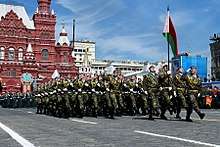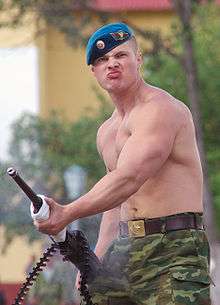Special Forces of Belarus
The Special Forces of Belarus (Belarusian: Cілы спецыяльных аперацый Узброеных Сіл Рэспублікі Беларусь) also known as the Spetsnaz of Belarus is a service branch of the Armed Forces of Belarus. Like all post-Soviet states, Belarus inherited its special forces (Spetsnaz) units from the remnants of the Soviet armed forces, GRU and KGB units. Belarus's units conduct joint exercises with the Armed Forces of Russia in which the nation's special forces participate extensively. Belarus's ruling party has been accused of using its special forces to assassinate opposition leaders.[5][6]
| Special Forces of Belarus | |
|---|---|
 Troops of the Special Forces during the 2015 Moscow Victory Day Parade. | |
| Founded | 2007 |
| Country | |
| Type | Special forces Airmobile |
| Role | Strategic deterrence Assassination |
| Size | 6,000[1] |
| Part of | Armed Forces of Belarus |
| Nickname(s) | "Winged Infantry" |
| Motto(s) | Nobody but us (Belarusian: Ніхто, акрамя нас!) Anywhere, anytime, any task (alternative) |
| Anniversaries | 2 August — Paratroopers' Day |
| Engagements | United Nations Interim Force in Lebanon[2] Libyan Civil War (2011)[3] |
| Commanders | |
| Current commander | Major General Vadim Denisenko[4] |
| Notable commanders | Major General Oleg Belokonev |
| Insignia | |
| Emblem |  |
| Flag |  |
History
In the early 90s, the military and political leadership of Belarus faced the question of the further fate of the legacy of the Soviet Army. The Belorussian Military District had three airborne units: one in Vitebsk, one in Brest and one in Maryina Gorka. A dilemma came when a defense doctrine was proclaimed, of which airborne units did not fit very well. Some leaders, proceeding from supposedly pacifist considerations, proposed a radical solution dismantling the airborne forces. In September 1995, mobile forces were formed on the basis of the 103rd Guards Airborne Division and the 38th Separate Guards Airborne Brigade as part of the 38th, 317th and 350th separate mobile brigades. They took part in the following operational tactical exercises: "Neman" (2001), "Berezina" (2002), "Clear Sky" (2003), "Shield of the Fatherland" (2004), and "Shield of the Union" (2006). Finally, on 2 August 2007, the formation of the Special Operations Forces was announced. They included two mobile forces brigades (38th and 103rd), the 5th separate special-purpose brigade.[7]
Composition
Army special operations forces include:[7]
- 38th Guards Air Assault Brigade (Brest)
- 103rd Guards Airborne Brigade (Vitebsk)
- 5th Spetsnaz Brigade (Marina Gorka)
There are units to perform the tasks of particular importance:
- 33rd Guards Spetsnaz Detachment (complete with officers and warrant officers)
- A special purpose detachment of 5th Spetsnaz Brigade (known as "company officer")
- 527th Spetsnaz Company
- 22nd Spetsnaz Company (Western Operational Command)
Professional training

Officers for special operations forces are trained by the military intelligence department of the Military Academy of Belarus. Students are trained in the following specialties: management of units and telecommunication systems. Field and practical exercises with the use of weapons and military equipment are held at a field training and material base.Future special forces officers are trained by following military universities in the Russian Armed Forces: the Novosibirsk Higher Military Command School and the Ryazan Higher Airborne Command School. After five years of training, cadets receive the military rank of Lieutenant.
Traditions
The current Special Operations Forces have most of the same traditions as units of the former Soviet Airborne Forces.
Motto
.jpg)
The official motto is Nobody but us (Belarusian: Ніхто, акрамя нас!).[8] An alternative motto is also, Anywhere, anytime, any task.
Symbols
The heraldic badge is the emblem of the Special Forces was approved in March 2012. It consists of the emblem of the special operations forces with a silver ten-pointed star.[9] The flag of the special operations forces is a rectangular cloth of blue color with a green stripe in the lower part. The ratio of the width of the green strip to the width of the flag is 1:3. The flag is 200 cm long and 133 cm wide. In the center of the blue strip of the banner is an image of the heraldic badge.
References
- The Military Balance 2017, p.203
- Кто такие белорусские миротворцы, как они могут появиться в чужой стране и можно ли им стрелять?
- На стороне Каддафи воюют белорусские партизаны — Комсомольская правда, 6 апреля 2011
- https://www.mil.by/ru/forces/sso/
- "Belarus: Special Forces Again Implicated In Opposition Disappearances". Radio Free Europe. 28 Aug 2001.
- "Pskov paratroopers and Belarus special forces to conduct manoeuvres in April". EN-TAS. 2 Apr 2014.
- "Special Operations Forces". www.mil.by. Belarus Ministry of Defense. Retrieved 2016-10-20.
- https://www.youtube.com/watch?v=oYmBdfqGmy0
- Указ Президента Республики Беларусь от 01.03.2012 №120